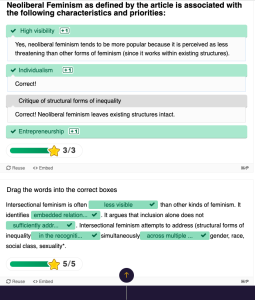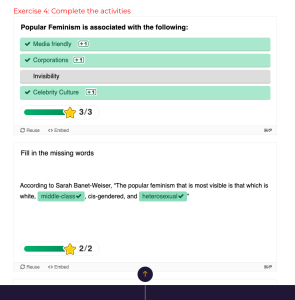3
Section One: The Fundamentals
A) Keywords
Exercise 1:
Briefly (in 100 words or less) define one of the keywords in the padlet (including one that you. may have added yourself).
| Performance advantage: is when an athlete naturally has traits that give them an edge over others. This can come from genetics, training, or environment. For example, Michael Phelps has a longer wingspan and produces less lactic acid, which helps him swim faster. In sports, these differences are usually accepted—unless they involve gender, like in the cases of Caster Semenya and Lia Thomas. It raises the question of fairness, since sports often celebrate natural advantages while selectively questioning others based on gender.
|
B) Representing Race
Exercise 2: Notebook Prompt
In about 50-70 words, consider Joel Bervell’s question: why do we feel the need to extrapolate the athleticism of one Black athlete to all Black people when we do not do the same for white athletes?
Try to think of examples when this happens, making sure to reflect on your own positionality.
| People tend to credit Black athletes’ success to genetics while praising white athletes for their hard work and training. When Usain Bolt dominated sprinting, the media focused on supposed Jamaican genetic traits, but when Michael Phelps broke records, his success was linked to coaching, dedication, and technique. This double standard ignores the years of effort all athletes put into their craft and reinforces outdated racial stereotypes. It’s unfair to assume one Black athlete’s abilities apply to all Black people, while white athletes are seen as individuals with unique skills and training.
|
C) Gender, Race & Sport
Exercise 3: Notebook Prompt
What are some strategies for resistance that Rajack and Joseph identify in their article as a means of pushing back against and resisting misogynoir?
|
Rajack and Joseph highlight a few key ways to push back against misogynoir in sports and media:
|
Section Two: Making Connections
A) Athlete Activism
Exercise 3: Padlet Prompt
Do athletes have a responsibility to use their platform for social change? Why or why not? Please remember to record your response in both the padlet below and in your Notebook.
B) Athlete Activism & Feminism
Exercise 4: Complete the activities


Exercise 5: Notebook Prompt
What do the authors of the article call for as a way of challenging how mainstream sports journalism privileges neoliberal feminist concerns? (100 words max.)
| The authors call for a shift from neoliberal feminism, which emphasizes individual success and corporate-friendly narratives, to an intersectional approach that addresses systemic inequalities in sports. They argue that mainstream sports journalism should move beyond marketable feminist icons and instead highlight the activism of marginalized athletes, particularly women of color. By focusing on structural inequalities rather than personal empowerment, the media can challenge exclusionary narratives and corporate co-optation of feminism. This requires greater representation, critical storytelling, and holding institutions accountable for reinforcing gender and racial hierarchies in sports coverage.
|
C) Corporate social justice
Exercise 6: Padlet Poll
| In the context of the Black Lives Matter (BLM) movement, sports leagues have exhibited varying degrees of support for athlete activism. The National Basketball Association (NBA) has been notably supportive, allowing players to express their views on social justice issues. For instance, during the 2020 season restart, NBA courts featured “Black Lives Matter” signage, and players were permitted to display social justice messages on their jerseys. In contrast, the National Football League (NFL) initially discouraged protests, notably when Colin Kaepernick began kneeling during the national anthem in 2016 to protest racial injustice. The NFL’s response evolved over time, especially following the widespread protests in 2020, leading to more acknowledgment of players’ rights to protest. These differing approaches highlight how sports leagues navigate the intersection of athletics and social justice, reflecting their unique cultures and leadership perspectives.
|
Section Three: Taking a shot
Module Assignment (submit as part of notebook and separately through Blackboard mini assignment #1 portal)
The 2021 film King Richard offers a compelling representation of racialized athlete activism through the story of Venus and Serena Williams and their father, Richard Williams. The film highlights the racial and socioeconomic challenges they face in a predominantly white sport while showcasing the ways they push back against systemic barriers. Richard Williams, in particular, acts as an activist by challenging the exclusionary nature of elite tennis, demanding respect for his daughters, and refusing to let them be exploited by a system that historically marginalized Black athletes.
One of the key strategies Richard and the Williams sisters use to advocate for themselves is controlling their own narrative. Richard’s refusal to allow Venus to play junior tournaments too early—despite pushback from coaches—was a form of resistance against a system that often drains young Black talent without guaranteeing long-term success. This aligns with Cooky and Antunovic’s (2020) discussion of how the media often obscures the activism of Black women in sports. Venus, by excelling on the court and eventually negotiating her own contracts, embodies an activist stance without explicitly engaging in protest.
The film also reflects what Boyle and Haynes describe as the power of sports media to shape cultural narratives. While King Richard is a celebratory film, it subtly critiques how sports institutions uphold racial hierarchies, reinforcing the idea that Black athletes must prove themselves in ways that white athletes do not. The racial and gendered dynamics in the film emphasize that Venus and Serena had to navigate not just racism but also sexism, as young Black women challenging traditional ideas of what a tennis champion should look like.
Ultimately, King Richard presents sport as both a site of oppression and resistance. It challenges audiences to see the Williams sisters not just as athletes, but as figures who redefine power in sports, much like Cooky and Antunovic argue that female athletes’ activism often goes unnoticed. This representation reinforces that sports are never just about the game; they are a reflection of larger societal struggles.

